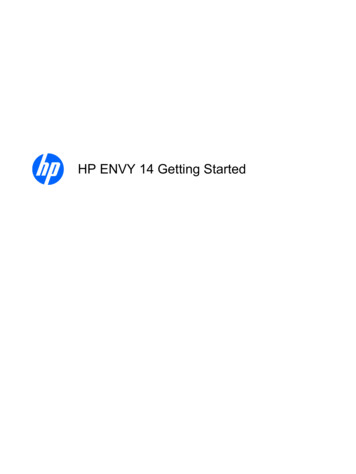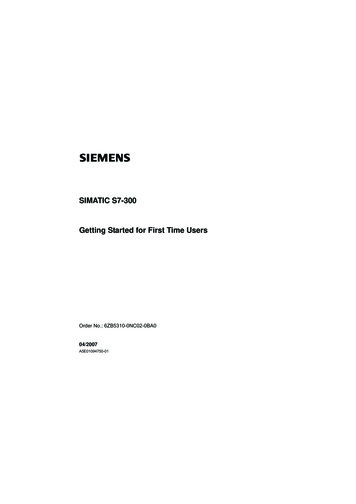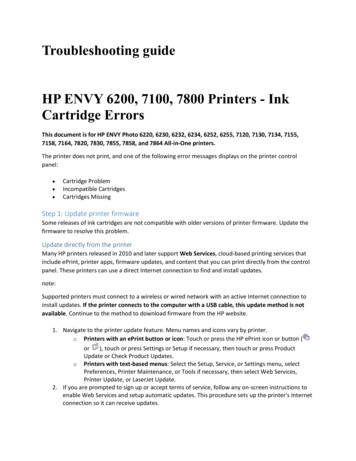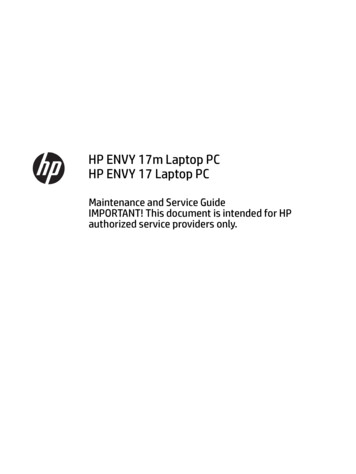
Transcription
HP ENVY 14 Getting Started
Copyright 2010 Hewlett-PackardDevelopment Company, L.P.ATI Catalyst and ATI Eyefinity are atrademarks of Advanced Micro Devices,Inc. Microsoft and Windows are U.S.registered trademarks of MicrosoftCorporation. Bluetooth is a trademarkowned by its proprietor and used byHewlett-Packard Company under license.SD Logo is a trademark of its proprietor.The information contained herein is subjectto change without notice. The onlywarranties for HP products and services areset forth in the express warranty statementsaccompanying such products and services.Nothing herein should be construed asconstituting an additional warranty. HP shallnot be liable for technical or editorial errorsor omissions contained herein.First Edition: August 2010Document Part Number: 621962-002Product noticeSoftware termsThis user guide describes features that arecommon to most models. Some featuresmay not be available on your computer.By installing, copying, downloading, orotherwise using any software productpreinstalled on this computer, you agree tobe bound by the terms of the HP End UserLicense Agreement (EULA). If you do notaccept these license terms, your soleremedy is to return the entire unusedproduct (hardware and software) within 14days for a refund subject to the refundpolicy of your place of purchase.For any further information or for requestinga full refund of the computer, pleasecontact your local point of sale (the seller).
User GuidesHP is committed to reducing theenvironmental impact of our products. Aspart of this effort, we provide user guidesand learning centers on your computer harddrive in Help and Support. Additionalsupport and updates to the user guides areavailable on the Web.
Safety warning noticeWARNING! To reduce the possibility of heat-related injuries or of overheating the computer, do notplace the computer directly on your lap or obstruct the computer air vents. Use the computer only ona hard, flat surface. Do not allow another hard surface, such as an adjoining optional printer, or a softsurface, such as pillows or rugs or clothing, to block airflow. Also, do not allow the AC adapter tocontact the skin or a soft surface, such as pillows or rugs or clothing, during operation. The computerand the AC adapter comply with the user-accessible surface temperature limits defined by theInternational Standard for Safety of Information Technology Equipment (IEC 60950).ENWWv
viSafety warning noticeENWW
Table of contents1 Welcome . 1What's new? . 2Using Stardock software . 2Using ATI Eyefinity Multi-Display technology . 2Example display configuration for single large surface (SLS) . 2Switching the screen image . 2Using the ATI Catalyst Control Center . 3Beats Audio . 3Finding information . 52 Getting to know your computer . 7Top . 7TouchPad . 7Lights . 8Button . 9Keys . 10Front . 11Right side . 12Left side . 14Display . 15Bottom . 163 Networking . 17Using an Internet service provider (ISP) . 18Connecting to a wireless network . 18Connecting to an existing WLAN . 18Setting up a new WLAN network . 19Configuring a wireless router . 20Protecting your WLAN . 204 Keyboard and pointing devices . 21Using the keyboard . 21Using the action keys . 21ENWWvii
Using the hotkeys . 23Using pointing devices . 24Setting pointing device preferences . 24Using the TouchPad . 24Turning the TouchPad on and off . 24Navigating . 24Selecting . 25Using TouchPad gestures . 25Scrolling . 26Pinching/Zooming . 265 Maintenance . 27Removing or inserting the battery . 27Removing the battery . 27Inserting the battery . 28Using the accessory battery (select models only) . 29Identifying the accessory battery components . 29Inserting or removing an accessory battery . 30Battery charging and discharging sequence . 31Replacing or upgrading the hard drive . 32Removing the hard drive . 32Installing a hard drive . 34Adding or replacing memory modules . 35Connecting an external monitor or projector . 38Updating programs and drivers . 39Routine care . 40Cleaning the display . 40Cleaning the TouchPad and keyboard . 406 Backup and recovery . 41Recovery discs . 42Performing a system recovery . 43Recovering using the dedicated recovery partition (select models only) . 43Recovering using the recovery discs . 43Backing up your information . 44Using Windows Backup and Restore . 44Using system restore points . 44When to create restore points . 45Create a system restore point . 45Restore to a previous date and time . 457 Customer support . 46Contacting Customer Support . 47viiiENWW
Labels . 478 Specifications . 49Input power . 49Operating environment . 49Index . 51ENWWix
xENWW
1WelcomeAfter you set up and register the computer, it is important to take the following steps:ENWW Connect to the Internet—Set up your wired or wireless network so that you can connect to theInternet. For more information, refer to Networking on page 17. Update your antivirus software—Protect your computer from damage caused by viruses. Thesoftware is preinstalled on the computer and includes a limited subscription for free updates. Formore information, refer to the HP Notebook Reference Guide. For instructions on accessing thisguide, refer to Finding information on page 5. Get to know your computer—Learn about your computer features. Refer to Getting to knowyour computer on page 7 and Keyboard and pointing devices on page 21 for additionalinformation. Create recovery discs—Recover the operating system and software to factory settings in caseof system instability or failure. For instructions, refer to Backup and recovery on page 41. Find installed software—Access a list of the software preinstalled on the computer. SelectStart All Programs. For details about using the software included with the computer, refer tothe software manufacturer's instructions, which may be provided with the software or on themanufacturer's Web site.1
What's new?Using Stardock softwareStardock software includes the following features: Stardock MyColors—Offers a customizable desktop theme that transforms the look and feel ofyour basic Windows desktop. The new desktop includes custom icons, visual styles (Start buttonand taskbar), and 3 corresponding wallpapers. To change back to the standard Windows theme,open the Stardock MyColors program and select the standard Windows theme. Stardock Fences—Organizes the icons on your desktop. When the custom theme has beenapplied, all of the icons on the desktop are moved to a vertical column or “fence” in the lower leftcorner of the screen, with the Recycle Bin at the top. To customize Fences or to access thesoftware Help, select Start All Programs Stardock. Click Fences, and then clickFences.lnk.Using ATI Eyefinity Multi-Display technologyYour computer supports the new ATI Eyefinity technology, which provides the following features: Allows you to use up to 2 external displays, as long as one of the displays is connected to theMini DisplayPort on the computer Provides a new display configuration by spanning the image across a group of external displaysinto a single large surface (SLS)Example display configuration for single large surface (SLS)You can use 2 external displays and span the image across them as an SLS. The 2 external displaysare connected to the computer using the Mini DisplayPort and the HDMI port.NOTE: Identical resolution is required between external displays to form an SLS. Displays withdifferent native resolutions can still form an SLS by using non-native resolutions.Switching the screen imagePress the switch screen image action key to open a dialog box that shows the 4 configurationchoices, independent of the number of connected display devices.2 Disconnect Projector mode—Turns off the external display and displays the image only on thecomputer display. Duplicate mode—Clones the computer display onto an external display that is connected to theHDMI port or the Mini DisplayPort on the computer.Chapter 1 WelcomeENWW
Extend mode—Extends the desktop to all connected external displays along with the computerdisplay. Projector only mode—Turns off the computer display and sets all connected external displays toextended desktop.NOTE: You can manage the video output and default output devices using the ATI Catalyst ControlCenter. Refer to Using the ATI Catalyst Control Center on page 3 for information.Using the ATI Catalyst Control CenterTo configure desktops and displays and to manage ATI Eyefinity, you must use the ATI Catalyst Control Center.To open the ATI Catalyst Control Center:1.Select Start All Programs Catalyst Control Center.2.Click the Graphics arrow, and then select Desktops and Displays.NOTE:Help.For additional information on using the ATI Catalyst Control Center, refer to the softwareBeats AudioBeats Audio is an enhanced audio profile that provides a deep, controlled bass while maintaining aclear sound. Beats Audio is enabled by default. To increase or decrease the Beats Audio bass settings, press fn (1) and the letter b (2).NOTE: You can also view and control the bass settings through the Windows operating system.Select Start, Control Panel Hardware and Sound HP Beats Audio Control Panel Equalization to view and control the bass properties.The following table shows and describes the Beats Audio icons.ItemENWWDescriptionBeats Audio3
Indicates that Beats Audio is enabled.Indicates that Beats Audio is disabled.4Chapter 1 WelcomeENWW
Finding informationThe computer comes with several resources to help you perform various tasks.ResourcesFor information aboutQuick Setup poster How to set up the computer Help to identify computer componentsHP Notebook Reference Guide Power management featuresTo access this guide, select Start Help and Support UserGuides. How to maximize battery life How to use the multimedia features of thecomputer How to protect the computer How to care for the computer How to update the softwareHelp and Support Operating system informationTo access Help and Support, select Start Help and Support. Software, driver, and BIOS updatesNOTE: For country- or region-specific support, go tohttp://www.hp.com/support, select your country or region, andfollow the on-screen instructions. Troubleshooting tools How to access technical supportRegulatory, Safety, and Environmental Notices Regulatory and safety informationTo access the notices, select Start Help and Support UserGuides. Battery disposal informationSafety & Comfort Guide Proper workstation setup, posture, health, andwork habits Electrical and mechanical safety informationTo access this guide:Select Start Help and Support User Guides.– or –Go to http://www.hp.com/ergo.Worldwide Telephone Numbers bookletHP support telephone numbersThis booklet is provided with your computer.ENWWHP Web site Support informationTo access this Web site, go to http://www.hp.com/support. Ordering parts and finding additional help Software, driver, and BIOS (Setup Utility) updates Accessories available for the deviceFinding information5
ResourcesFor information aboutLimited Warranty*Warranty informationTo access the warranty:Select Start Help and Support HP Warranty.– or –Go to http://www.hp.com/go/orderdocuments.*You can find the expressly provided HP Limited Warranty applicable to your product located with the electronic guides onyour computer and/or on the CD/DVD provided in the box. Some countries/regions may provide a printed HP LimitedWarranty in the box. In countries/regions where the warranty is not provided in printed format, you may request a printedcopy at http://www.hp.com/go/orderdocuments or write to: North America: Hewlett Packard, MS POD, 11311 Chinden Blvd, Boise, ID 83714, USA Europe, Middle East, Africa: Hewlett Packard, POD, Via G. Di Vittorio, 9, 20063, Cernusco s/Naviglio (MI), Italy Asia Pacific: Hewlett Packard, POD, P.O. Box 200, Alexandra Post Office, Singapore 911507.Please include your product name, warranty period (found on your serial number label), name and postal address.6Chapter 1 WelcomeENWW
2Getting to know your hPad lightTurns the TouchPad on and off. Quickly double-tap theTouchPad light to turn the TouchPad on and off.(2)TouchPad zoneMoves the pointer and selects or activates items on thescreen.(3)Left TouchPad buttonFunctions like the left button on an external mouse.(4)Right TouchPad buttonFunctions like the right button on an external mouse.Top7
LightsComponent(1)(2)(3)(4)DescriptionTouchPad lightPower lightMute lightWireless light Amber: The TouchPad is off. Off: The TouchPad is on. White: The computer is on. Blinking white: The computer is in the Sleep state. Off: The computer is off or in Hibernation. Amber: Computer sound is off. Off: Computer sound is on. White: An integrated wireless device, such as awireless local area network (WLAN) device, is on.NOTE: 8Chapter 2 Getting to know your computerWireless devices are enabled at the factory.Amber: All wireless devices are off.ENWW
ButtonComponentPower buttonDescription When the computer is off, press the button to turn on thecomputer. When the computer is on, press the button briefly toinitiate Sleep. When the computer is in the Sleep state, press the buttonbriefly to exit Sleep. When the computer is in Hibernation, press the buttonbriefly to exit Hibernation.If the computer has stopped responding and Windows shutdown procedures are ineffective, press and hold the powerbutton for at least 5 seconds to turn off the computer.To learn more about your power settings, select Start Control Panel System and Security Power Options, orrefer to the HP Notebook Reference Guide.ENWWTop9
KeysComponent10Description(1)esc keyDisplays system information when pressed in combinationwith the fn key.(2)fn keyExecutes frequently used system functions when pressedin combination with the b key or the esc key.(3)Windows logo keyDisplays the Windows Start menu.(4)Windows applications keyDisplays a shortcut menu for items beneath the pointer.(5)Action keysExecute frequently used system functions.(6)Optical drive eject keyOpens the optical drive.Chapter 2 Getting to know your computerENWW
FrontComponentENWWDescription(1)Speakers (2)Produce sound.(2)Bluetooth compartmentContains a Bluetooth device.(3)Digital Media SlotSupports the following digital card formats: MultiMediaCard Secure Digital (SD) Memory Card Secure Digital High Capacity Memory Card Secure Digital Extended Capacity Memory CardFront11
Right sideComponent(1)(2)DescriptionPower lightDrive light White: The computer is on. Blinking white: The computer is in the Sleep state. Off: The computer is off or in Hibernation. Blinking white: The hard drive is being accessed. Amber: HP ProtectSmart Hard Drive Protection hastemporarily parked the hard drive.NOTE: For information on HP ProtectSmart HardDrive Protection, refer to the HP NotebookReference Guide.(3)eSATA/USB portConnects a high-performance eSATA component, such asan eSATA external hard drive, or connects an optionalUSB device.(4)HDMI portConnects an optional video or audio device, such as ahigh-definition television, or any compatible digital oraudio component.(5)Mini DisplayPortConnects an optional digital display device, such as ahigh-performance monitor or projector.(6)Security cable slotAttaches an optional security cable to the computer.NOTE: The security cable is designed to act as adeterrent, but it may not prevent the computer from beingmishandled or stolen.(7)RJ-45 (network) jackConnects a network cable.(8)VentEnables airflow to cool internal components.NOTE: The computer fan starts up automatically to coolinternal components and prevent overheating. It is normalfor the internal fan to cycle on and off during routineoperation.12Chapter 2 Getting to know your computerENWW
Component(9)(10)ENWWDescriptionBattery lightPower connector Off: The computer is running on battery power. Blinking amber: The battery has reached a lowbattery level, a critical battery level, or there is abattery error. Amber: A battery is charging. White: The computer is connected to external powerand the battery is fully charged.Connects an AC adapter.Right side13
Left sideComponent(1)DescriptionOptical driveReads and writes to an optical disc.CAUTION: Do not insert 8-cm optical discs into theoptical drive. This can cause damage to the computer.(2)USB ports (2)Connect optional USB devices.(3)Audio-out (headphone) jack/Audio-in(microphone) jackProduces sound when connected to optional poweredstereo speakers, headphones, earbuds, a headset, ortelevision audio. Also connects an optional headsetmicrophone.WARNING! To reduce the risk of personal injury, adjustthe volume before putting on headphones, earbuds, or aheadset. For additional safety information, refer to theRegulatory, Safety, and Environmental Notices.NOTE: When a device is connected to the jack, thecomputer speakers are disabled.NOTE: Be sure that the device cable has a 4-conductorconnector that supports both audio-out (headphone) andaudio-in (microphone).(4)Audio-out (headphone) jackProduces sound when connected to optional poweredstereo speakers, headphones, ear buds, a headset, ortelevision audio.WARNING! To reduce the risk of personal injury, adjustthe volume before putting on headphones, earbuds, or aheadset. For additional safety information, refer to theRegulatory, Safety, and Environmental Notices.NOTE: When a device is connected to the jack, thecomputer speakers are disabled.14Chapter 2 Getting to know your computerENWW
DisplayComponentDescription(1)WWAN antennas (2)* (select models only)Send and receive wireless signals to communicate with wirelesswide-area networks (WWAN).(2)WLAN antennas (2)*Send and receive wireless signals to communicate with wirelesslocal area networks (WLAN).(3)Internal microphones (2)Record sound.(4)WebcamRecords video and captures still photographs.To access the webcam, select Start All Programs HP HPMediaSmart HP MediaSmart Webcam.(5)Webcam lightOn: The webcam is in use.*The antennas are not visible from the outside of the computer. For optimal transmission, keep the areas immediatelyaround the antennas free from obstructions. To see wireless regulatory notices, refer to the section of the Regulatory, Safety,and Environmental Notices that applies to your country or region. These notices are located in Help and Support.ENWWDisplay15
BottomComponentDescription(1)Memory module compartmentContains the memory module slot.(2)Vents (3)Enable airflow to cool internal components.NOTE: The computer fan starts up automatically to coolinternal components and prevent overheating. It is normal forthe internal fan to cycle on and off during routine operation.(3)SIM slot (select models only)Contains a wireless subscriber identity module (SIM). TheSIM slot is located inside the battery bay.(4)Accessory battery connectorConnects an optional accessory battery.(5)Battery cover release latchReleases the battery cover.(6)Battery bayHolds the battery and the hard drive.NOTE: The battery is preinstalled in the battery bay at thefactory.16Chapter 2 Getting to know your computerENWW
3NetworkingNOTE: Internet hardware and software features vary depending on computer model and yourlocation.Your computer supports two types of Internet access:ENWW Wireless—For mobile Internet access, you can use a wireless connection. Refer to Connectingto an existing WLAN on page 18 or Setting up a new WLAN network on page 19. Wired—You can access the Internet by connecting to a wired network. For information onconnecting to a wired network, refer to the HP Notebook Reference Guide.17
Using an Internet service provider (ISP)Before you can connect to the Internet, you must establish an ISP account. Contact a local ISP topurchase Internet service and a modem. The ISP will help set up the modem, install a network cableto connect your wireless computer to the modem, and test the Internet service.NOTE: Your ISP will give you a user ID and password to access the Internet. Record thisinformation and store it in a safe place.The following features will help you set up a new Internet account or configure the computer to use anexisting account: Internet Services & Offers (available in some locations)—This utility assists with signing upfor a new Internet account and configuring the computer to use an existing account. To accessthis utility, select Start All Programs Online Services Get Online. ISP-provided icons (available in some locations)—These icons may be displayed eitherindividually on the Windows desktop or grouped in a desktop folder named Online Services. Toset up a new Internet account or configure the computer to use an existing account, double-clickan icon, and then follow the on-screen instructions. Windows Connect to the Internet Wizard—You can use the Windows Connect to the InternetWizard to connect to the Internet in any of these situations: You already have an account with an ISP. You do not have an Internet account and want to select an ISP from the list provided withinthe wizard. (The list of ISP providers is not available in all regions.) You have selected an unlisted ISP, and the ISP has provided you with information such asa specific IP address and POP3 and SMTP settings.To access the Windows Connect to the Internet Wizard and instructions for using it, select Start Help and Support, and then type Connect to the Internet wizard in the Search box.NOTE: If you are prompted within the wizard to choose between enabling or disablingWindows Firewall, choose to enable the firewall.Connecting to a wireless networkWireless technology transfers data across radio waves instead of wires. Your computer may beequipped with one or more of the following wireless devices: Wireless local area network (WLAN) device HP Mobile Broadband Module, a wireless wide area network (WWAN) device Bluetooth deviceFor more information on wireless technology and connecting to a wireless network, refer to the HPNotebook Reference Guide and information and Web site links
Stardock Fences—Organizes the icons on your desktop. When the custom theme has been applied, all of the icons on the desktop are moved to a vertical column or "fence" in the lower left corner of the screen, with the Recycle Bin at the top. To customize Fences or to access the software Help, select Start All Programs Stardock.











